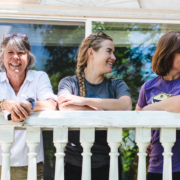The Power of Groups

Last year, Colorado Recovery expanded services outside the signature continuum of care, and started admitting directly into our intensive outpatient program (IOP) clients who may be ready to begin their recovery at the IOP level of care, or for those in the process of stepping down from another program.
Community integration and social engagement continue to be at the heart of our approach, setting the course for a life of engagement, purpose, and connection. This non-institutional approach created by the late Colorado Recovery founder Richard Warner is key to outcomes associated with independence and self-respect.
Dr. Warner considered schizophrenia and similar conditions bio-psycho-social disorders significantly affected by the environment surrounding the client on multiple levels. The Warner method harnesses the benefits of client empowerment to increase skills and work preparedness and assist them with social integration.
Our groups are an integral part of that treatment approach. “We have all sorts of different groups: a hiking group, a musical group, art therapy, a movement group, motivational therapy, the ACT therapy group (acceptance and commitment) therapy group—all different kinds of groups, all different kinds of approaches for clients to progress in their recovery,” says admissions coordinator Julie Owen, MA.
Every IOP patient is assigned a therapist who participates in the weekly treatment planning meeting with the team’s psychiatrists and other treatment staff. Groups include dialectical behavioral therapy (DBT), cognitive behavioral therapy (CBT), co-existing disorders group for psychiatric illness and substance misuse issues, the breakfast group, an art therapy group, the movement therapy group, the creative writing group, and a garden group as well as various activity groups.
One of the groups available at the IOP level is movement therapy. Dance/movement therapy (DMT) is defined by the American Dance Therapy Association as “the psychotherapeutic use of movement to promote emotional, social, cognitive, and physical integration of the individual, for the purpose of improving health and well-being.”
“The basic tenet is that emotions live in the body,” says Colorado Recovery’s movement therapist Elise Alvarez. “It’s about creating awareness around clients, and then movement to process those emotions. In case of anger management issues, we could ask ‘Is there a specific part of your body that you feel anger in?’ Anxiety might manifest as feeling a weight in the chest.”
By expanding the awareness of such feelings, people are better able to recognize what’s happening in each present moment and then make more informed decisions about their feelings instead of simply reacting to them impulsively.
Meaningful employment is an important aspect of the treatment model originated by Dr. Warner. Clinical research shows that employment can improve outcomes of mental health treatment. “Several studies have shown that patients discharged from psychiatric hospital who have a job are much less likely to be readmitted to hospital than those who are unemployed, regardless of the patient’s level of pathology,” Dr. Warner wrote in The Environment of Schizophrenia.
“Finding suitable employment for clients as part of their treatment plan is the task of the employment group,” explains vocational rehabilitation counselor Dalma Farkas. “Clients learn and practice social skills which are essential for job searches and placements. Participants receive continued support, assistance, and encouragement—from each other as well—to successfully get back into the labor market.”
Employment support includes helping clients find a job, go back to school, or find volunteer work in the community. The group covers a lot of territory: how to write a stellar resume, how to prepare for a job interview, and how to keep a job.
Farkas usually gets things rolling with a thorough career assessment. “I ask them what they would like to do, what’s their dream job? I inquire about their job record and also find out what didn’t work for them to avoid bad experiences in the future.”
Another offering available at the IOP level is our Treehouse group. It’s “a safe space to take a break and just hang out,” says Treehouse community organizer Elise Alvarez. “At the same time, it’s a great opportunity to build more comfortable relationships.” The Treehouse group highlights the value of social integration, “many people have found roommates and best friends here,” says Alvarez. “Treehouse gives a population that doesn’t have too much opportunity to socialize the chance to do just that.”
It’s important to give clients some measure of control, to let them work out the budget and create the space the way they want it to be. “We typically start with me making announcements, and then open the floor to things they want to talk about,” explains Alvarez. “We’ve had discussions about terminology: should it be mental illness or biopsychosocial disease? Other times, we plan out dinners or days at the beach.”
Our groups help prepare our clients for success in relationships, volunteer work, education and training, internships, and job placements.
For more information about direct admission to our intensive outpatient program or our other services, connect with a specialist who can answer your questions at (720) 218-4068.





